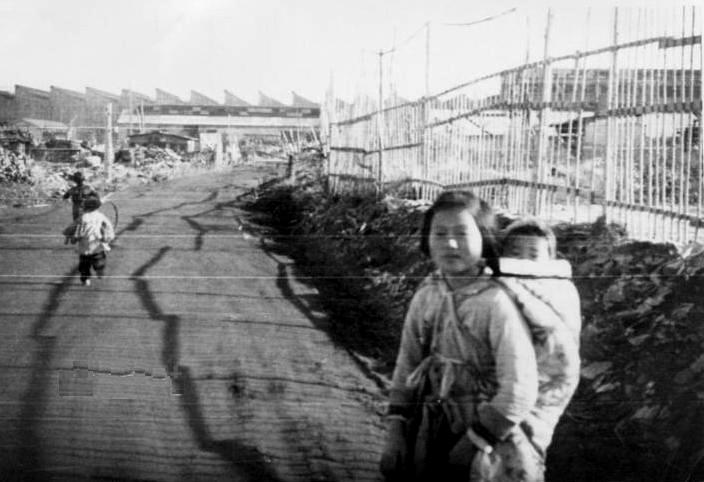
World War II Stategic Bombing Campaign Raids: Nagoya (March 11-12, 1945)

Figure 1.--The Japanese began the War thinking that while they could bomb at will in China that their cities could not be reached by foreign bombers. The result was years of terror bombing. This proved to be a terrible mistake. The Nagoya aircraft factories were one of the highest priority targets of the bombing campaign. Here is what one of the Nagoya aircraft plahts looked like after the B-29 raids. We are not sure when this snapshot was taken, but suspect that it was after Japan surrendeed, probably about November 1945.
|
|
The next big raid after Tokyo (March 9-10) was the port of Nagoya. This was a relatively new city and port, founded only in 1889. Nagoya is located along the Pacific coast on central Honshu. It is the capital of Aichi Prefecture.
At the time of the War, Nagou\ya was Japan's second largest port after Yokohama. Nagoya was Japan's third most populous city, about 1.5 million people. Nagoya had been famous for its fine ceramics, which were widely marketed in the United States. As the war moved inexorably toward Japan, Nagoya was an important target. Not only was it an important port, but it was aajor center for aircraft production. Several important aircraft plants which were clustered around the Kagamigahara airfield. This made attacking Japan's aircraft industry much easier than the difficult job of destroying the more dispersed German aircrft industry. Mitsubishi, Japan's most important aircraft manufactur, established its largest aircraft assembly works in Nagoya and it was the second largest in the world. Aichi also had a large airframe and engine plant. Aichi produced about 1,600 engines per month in 1944 before the strategic bombing campaign began. About a quarter of the city's workers were employed in the aircraft plants. In addition to the aircraft plants, Nagoya also had important shipyards. .
Primarily because of the aircraft industries, Nagoya was after Tokyo at the top of the list of General LeMay's lists of targets. Japanese planes were by this point of the War largely obsolete, but they were still a formidable weapon when used in Kamikazee attacks. Nagoya proved to be one of the most difficult targets for American bombers.
LeMay first sent a force of 310 B-29 Superfortresses armed with incendiary bombs to attack the city (March 11-12). The post-bombing assessment was that 2 square miles of the city were destroyed in a fire storm. This was, however, considered disappointing compared with the devastation created by the Tokyo raid. Planners concluded that the destruction was more limited because of the decision to spread out the incendiaries dropped from each aircraft over a larger area than ws the case in the Tokyo raid.
As a result, Le May sent a much larger force against Nagoya for a subseuent raid. A force of 542 B-29s went back to Nagoya (May 14). They dropped 2,515 tons of incendiaries bombs. The second raid destroyed 3.15 square of the city.
A third raid executed at night at low levels hit Nagoya again (May 17-18). This raid consisted of 516 B-29s which dropped over 3,609 tons of bombs, The raid destroyed another 3.9 square miles of the city.
USAAF analists saw that some of the city's industry was still operating. Thus a final raid by 194 B-29s of 313 and 314 Bombardment Wings targeted the machine tools at Number 2 and Number 4 engine works (April 7). They destroyed 40 percent of production. This was ranked as the the single most devastating raid against an aircraft plant during the War. It was also one of the first raids of the war with P-51 Mustang escorts. The escorts were now possible because of the sacrifices the Marines made taking Iwo Jima.
One assessment of the results of the bombing reports 18,759 casualties and 8,079 killed. These numbers are far below the Tokyo bombing. Nagoya was a large city, but smaller than Tokyo and more non-wooden structures. In addition there was not one mssive fore storm, but rather the raids were smaller and scatteed out over 3 months. Total destruction included 136,556 and extend to 12.4 square miles, rg\hat was over 30 percent of the city.
USAAF analysts after the War concluded that Nagoya was "... one of the most difficult cities in Japan to burn because of the difficulties of the approach, the shape and size of the city, the relatively small fire divisions in the urban sections, the numerous fire breaks and the high percentage of fire resistant structures." [Frank] The Nagoya raids and subequent raids on other aircraft plants were important because they largely destroyed the country's aircraft industries. It meant that Japan would have to make do largely with planes already built for its Secret Airforce being pulled together to assault the planned American invasion fleet.
Sources
Frank, Richard B. Downfall: The End of the Imperial Japanese Empire (Random House: 1999).
HBC

Navigate the Boys' Historical Clothing Web Site:
[Return to Main Asian strategic bombing campaign]
[Return to Main Asian air campaign]
[Return to Main World War II Pacific campaign page]
[Return to Main World War II air campaign page]
[Biographies]
[Campaigns]
[Children]
[Countries]
[Deciding factors]
[Diplomacy]
[Geo-political crisis]
[Economics]
[Home front]
[Intelligence]
[Resistance]
[Race]
[Refugees]
[Technology]
[Bibliographies]
[Contributions]
[FAQs]
[Images]
[Links]
[Registration]
[Tools]
[Return to Main World War II page]
[Return to Main war essay page]
Created: 9:49 AM 9/14/2012
Last updated: 9:49 AM 9/14/2012



